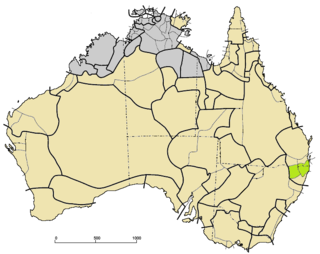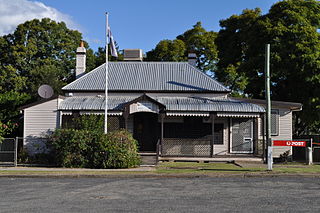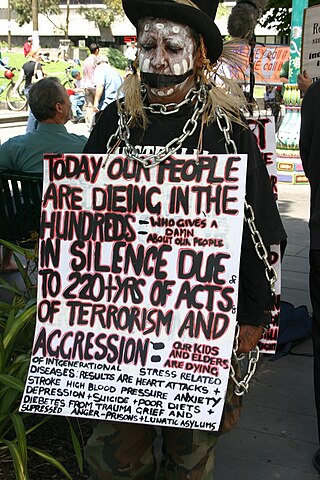
Mullumbimby is a town in the Byron Shire in the Northern Rivers region of New South Wales, Australia. It promotes itself as "The Biggest Little Town in Australia". The town lies at the foot of Mount Chincogan in the Brunswick Valley about 9 kilometres by road from the coast. At the 2021 census, Mullumbimby and the surrounding area had a population of 3,589 people. It is known for its hippie subculture.

Yugambeh, also known as Tweed-Albert Bandjalang, is an Australian Aboriginal language spoken by the Yugambeh living in South-East Queensland between and within the Logan River basin and the Tweed River basin, bounded to the east by the Pacific Ocean and in the west by the Teviot Ranges and Teviot Brook basin.

Yugambeh–Bundjalung, also known as Bandjalangic, is a branch of the Pama–Nyungan language family, that is spoken in north-eastern New South Wales and South-East Queensland.

Tabulam is a rural village in the far north-east of New South Wales, Australia, 800 kilometres from the state capital, Sydney. Tabulam is located on the Bruxner Highway between Tenterfield and Casino and on the Clarence River. According to the 2016 census, there were 470 people living in Tabulam. The main village is administered by Kyogle Council, while the section of Tabulam west of the Clarence River is part of Tenterfield Shire.
The Gidabal, also known as Kitabal and Githabul, are an indigenous Australian tribe of southern Queensland, who inhabited an area in south-east Queensland and north-east New South Wales, now within the Southern Downs, Tenterfield and Kyogle Local Government regions.
The Richmond River massacres were a series of murders of groups of Indigenous Australians and European Australians in the region around the Richmond River in north-eastern New South Wales in the mid-nineteenth century.
The Hornet Bank massacre was the killing of eleven British settlers, which included eight members of the Fraser family, by a group of mostly Yiman Indigenous Australians. The massacre occurred at about one or two o'clock in the morning of 27 October 1857 at Hornet Bank station on the upper Dawson River near Eurombah in central Queensland, Australia. It has been moderately estimated that 150 Aboriginal people succumbed in subsequent punitive expeditions conducted by Native Police, private settler militias, and by William Fraser in or around Eurombah district. Indiscriminate shootings of "over 300" Aboriginal men, women, and children, however, were reportedly conducted by private punitive expedition some 400 kilometres eastward at various stations in the Wide Bay district alone. The result was the near-extermination of the entire Yiman tribe and language group by 1858; this claim was disputed, however, and descendants of this group have recently been recognised by the High Court of Australia to be the original custodians of the land surrounding the town of Taroom.

Dja Dja Wurrung, also known as the Djaara or Jajowrong people and Loddon River tribe, are an Aboriginal Australian people who are the traditional owners of lands including the water catchment areas of the Loddon and Avoca rivers in the Bendigo region of central Victoria, Australia. They are part of the Kulin alliance of Aboriginal Victorian peoples. There are 16 clans, which adhere to a patrilineal system. Like other Kulin peoples, there are two moieties: Bunjil the eagle and Waa the crow.

The Bundjalung people, also spelled Bunjalung, Badjalang and Bandjalang, are Aboriginal Australians who are the original custodians of a region from around Grafton in northern coastal New South Wales to Beaudesert in south-east Queensland. The region is located approximately 550 kilometres (340 mi) northeast of Sydney and 100 kilometres (62 mi) south of Brisbane that now includes the Bundjalung National Park.
The Jardwadjali (Yartwatjali), also known as the Jaadwa, are an Aboriginal Australian people of the state of Victoria, whose traditional lands occupy the lands in the upper Wimmera River watershed east to Gariwerd (Grampians) and west to Lake Bringalbert.

The Yugambeh, also known as the Minyangbal, or Nganduwal, are an Aboriginal Australian people of South East Queensland and the Northern Rivers of New South Wales, their territory lies between the Logan and Tweed rivers. A term for an Aboriginal of the Yugambeh tribe is Mibunn, which is derived from the word for the Wedge-tailed Eagle. Historically, some anthropologists have erroneously referred to them as the Chepara, the term for a first-degree initiate. Archaeological evidence indicates Aboriginal people have occupied the area for tens of thousands of years. By the time European colonisation began, the Yugambeh had a complex network of groups, and kinship. The Yugambeh territory is subdivided among clan groups with each occupying a designated locality, each clan having certain rights and responsibilities in relation to their respective areas.
The Kombumerri clan are one of nine distinct named clan estate groups of the Yugambeh people and the name refers to the Indigenous people of the Nerang area on the Gold Coast, Queensland. Australia
The Geynyon, also written Keinjan, are an indigenous Australian people of southern Queensland. According to research done by Queensland South Native Title Services (QSNTS) entitled South East Regional Research Project (SERRP) 'Geynyan' are in all likelihood an dialect/estate group of the wider Githabul peoples. In May 2021 the Githabul peoples lodged a Native Title claim over much of the former Warwick Shire within the Southern Downs Regional Council area.
Waalubal (Wahlubal), also known as Western Bundjalung, Baryulgil, and Middle Clarence Bandjalang, is an Australian Aboriginal language spoken by the Western Bundjalung living in North-East New South Wales.
The Mununjali clan are one of nine distinct named clan estate groups of the Yugambeh people, an Aboriginal Australian nation whose traditional lands are the Beaudesert area in the Scenic Rim, Queensland, Australia.
Margaret Clare Sharpe is a linguist of Australian Aboriginal languages, specializing in Yugambeh-Bundjalung languages, with particular regard to Yugambir, She has also done important salvage fieldwork on the Northern Territory Alawa language.
Criminal activity in New South Wales, Australia is combated by the New South Wales Police Force and the New South Wales court system, while statistics about crime are managed by the Bureau of Crime Statistics and Research. Modern Australian states and cities, including New South Wales, have some of the lowest crime rates recorded globally with Australia ranked the 13th safest nation and Sydney ranked the 5th safest city globally. As of September 2018 the City of Penrith (475.7) and City of Blacktown (495.1). Rural areas have comparatively high crime rates per 100,000 with rural shires such as Walgett Shire (1350.3) and Moree Plains Shire (1236.2) having some of the highest violent crime rates in the state. The overall NSW crime rate has been in steady decline for many years.
The Tulgiginclan are one of nine distinct named clan estate groups of the Yugambeh people and the name refers to the Indigenous people of the Tweed area in the Tweed Shire, New South Wales, Australia.

Yued is a region inhabited by the Yued people, one of the fourteen groups of Noongar Aboriginal Australians who have lived in the South West corner of Western Australia for approximately 40,000 years.